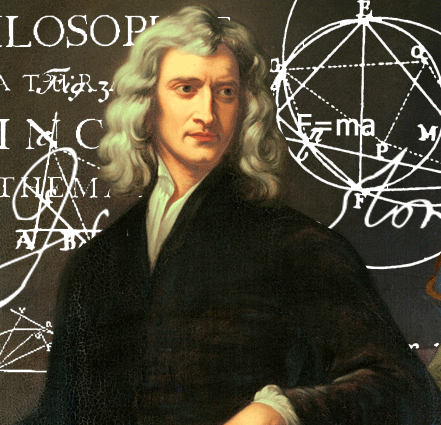Newton, Sir Isaac (1642-1727), English natural philosopher, generally regarded as the most original and influential theorist in the history of science. In addition to his invention of the infinitesimal calculus and a new theory of light and color, Newton transformed the structure of physical science with his three laws of motion and the law of universal gravitation. As the keystone of the scientific revolution of the 17th century, Newton's work combined the contributions of Copernicus, Kepler, Galileo, Descartes, and others into a new and powerful synthesis. Three centuries later the resulting structure - classical mechanics - continues to be a useful but no less elegant monument to his genius.

Isaac Newton was born prematurely on Christmas day 1642 (4 January 1643, New Style) in Wools Thorpe, a hamlet near Grantham in Lincolnshire. The posthumous son of an illiterate yeoman (also named Isaac), the fatherless infant was small enough at birth to fit 'into a quart pot'.
“It’s good to be inquisitive. Ask why? Just don’t agree to everything.”
Once there was a terrible wind storm on the farm. His mother was worried that the wind might break gates, doors and shutters. She sent Isaac out to check all over the farm buildings and fences to make sure there wasn't anything flapping in the wind.
Isaac went out, but he didn't come back. He looked at the strong wind blowing things all around and thought "I wonder ..."
His mother waited and waited, then went out looking for him. When she found him, he was jumping up off a fence over and over to see how far the wind would carry him. He had gotten thinking about how strong the wind was, and forgot completely about everything else.
In 1665 Newton took his bachelor's degree at Cambridge without honors or distinction. Since the university was closed for the next two years because of plague, Newton returned to Wools Thorpe in midyear. There, in the following 18 months, he made a series of original contributions to science. As he later recalled, 'All this was in the two plague years of 1665 and 1666, for in those days I was in my prime of age for invention, and minded mathematics and philosophy more than at any time since.' In mathematics Newton conceived his 'method of fluxions' (infinitesimal calculus), laid the foundations for his theory of light and color, and achieved significant insight into the problem of planetary motion, insights that eventually led to the publication of his Principia (1687).
In 1666, as tradition has it, Newton observed the fall of an apple in his garden at Wools Thorpe, later recalling, 'In the same year I began to think of gravity extending to the orb of the Moon.'
Meanwhile, in the coffeehouses of London, Hooke, Edmund Halley, and Christopher Wren struggled unsuccessfully with the problem of planetary motion. Finally, in August 1684, Halley paid a legendary visit to Newton in Cambridge, hoping for an answer to his riddle: What type of curve does a planet describe in its orbit around the sun, assuming an inverse square law of attraction? When Halley posed the question, Newton's ready response was 'an ellipse.' When asked how he knew it was an ellipse Newton replied that he had already calculated it. Although Newton had privately answered one of the riddles of the universe--and he alone possessed the mathematical ability to do so--he had characteristically misplaced the calculation. After further discussion he promised to send Halley a fresh calculation forthwith. In partial fulfillment of his promise Newton produced his De Motu of 1684. From that seed, after nearly two years of intense labor, the Philosophize Naturalism Principia Mathematical appeared. Arguably, it is the most important book published in the history of science. But if the Principia was Newton's brainchild, Hooke and Halley were nothing less than midwives.
During his London years Newton enjoyed power and worldly success. His position at the Mint assured a comfortable social and economic status, and he was an active and able administrator. After the death of Hooke in 1703, Newton was elected president of the Royal Society and was annually reelected until his death. In 1704 he published his second major work, the Optics, based largely on work completed decades before. He was knighted in 1705.
In his later life, when asked for an assessment of his achievements, he replied, "I do not know what I may appear to the world; but to myself I seem to have been only like a boy playing on the seashore, and diverting myself now and then in finding a smoother pebble or prettier shell than ordinary, while the great ocean of truth lay all undiscovered before me."
Newton's final gesture before death was to refuse the sacrament, a decision of some consequence in the 18th century. Newton's research outside of science--in theology, prophecy, and history--was a quest for coherence and unity. His passion was to unite knowledge and belief, to reconcile the Book of Nature with the Book of Scripture. But for all the elegance of his thought and the boldness of his quest, the riddle of Isaac Newton remained. In the end, Newton is as much an enigma to us as he was, no doubt, to himself.
Although his creative years had passed, Newton continued to exercise a profound influence on the development of science. Until his death he dominated the landscape of science without rival. He died in London on March 20, 1727 (March 31, New Style).
To every action there is always opposed an equal reaction.
We build too many walls and not enough bridges.
- Isaac Newton